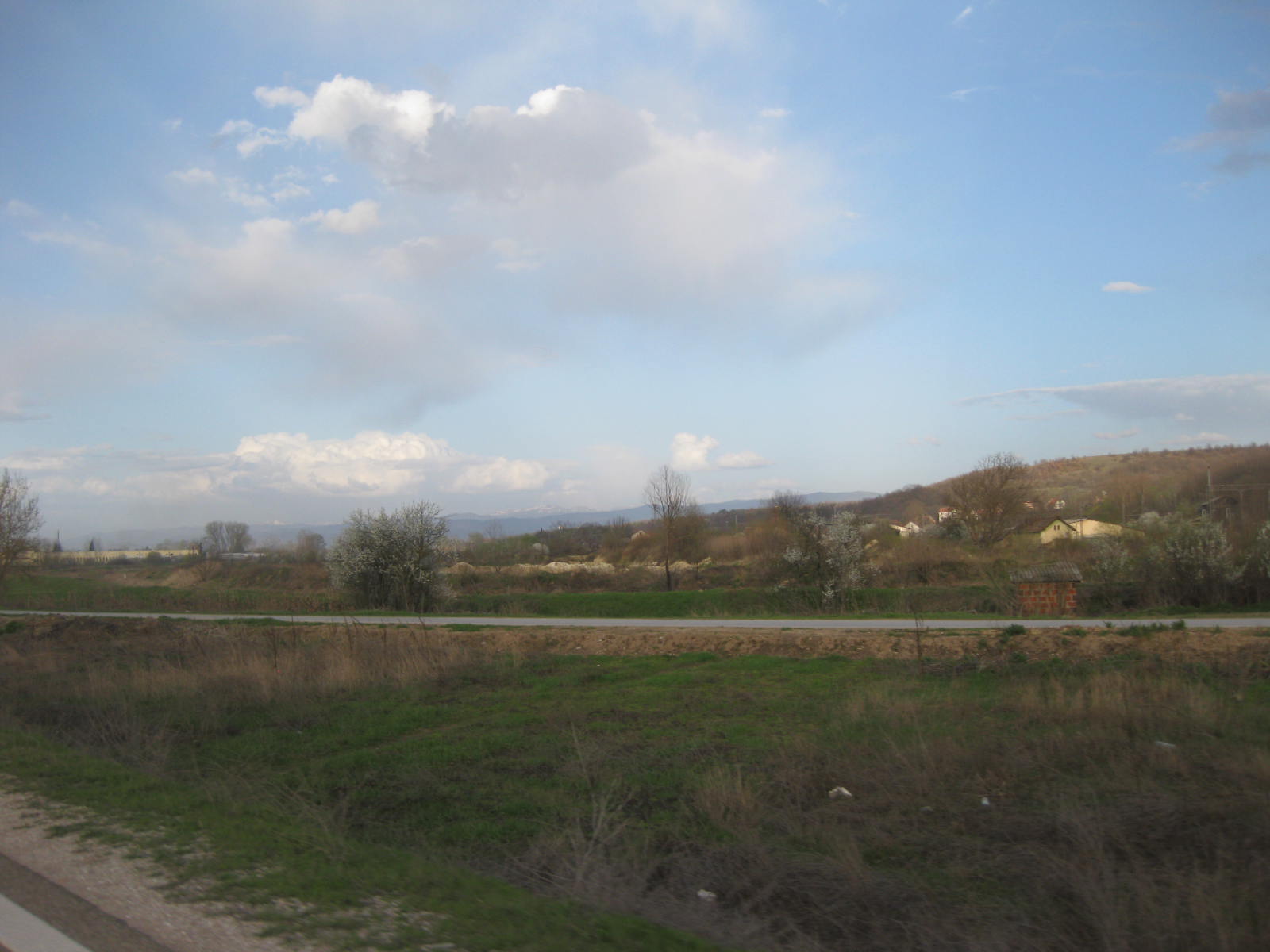I just had to add one more photo of driving in the Balkans. I think this was in Serbia just south of Nis. It's a guy standing on a horse-drawn cart as he drives. Also notice the car parked on the sidewalk in front of the store. (At least there is a little room here for pedestrians.)
A photo taken from the car as we drove into Serbia from Macedonia. Basically, the view included hilly countryside with mountains in the background and lots of small villages.
We visited one of my colleagues named Cleyara, a fellow ELF (English Language Fellow) from Texas, in Nis. Since she hasn't been able to explore that much outside of the big towns and we had a car, so we told her to pick a place she wanted to visit. She chose "Devil's Town" which is an area with hoodoo formations like those found in Bryce Canyon, Utah, but on a much smaller scale. Unfortunately, when we were a couple of miles from the site, we got a flat tire from a nail and this is Frank starting to fix it in the pouring rain. At Devil's Town, I decided to stay in the car and not trek 30 minutes into the muddy, wet hills to view the hoodoos. Frank and Cleyara braved the weather and had fun exploring. I will let Frank post some photos about what they saw. At the site, there were no other tourists, but the guy who sold tickets to the site was there as well as a local who sold raki. I bought some pear brandy from him.
A local with part of his small herd of cows in Southern Serbia.
A barn in Southern Serbia
Trg Kralja Milana in Nis - the main square in the city center
Nis is the 3rd largest city in Serbia and was founded over 2000 years ago. It's main claim to fame is that it is the birthplace of Constantine the Great who was born in Nis in 272. In 312, Constantine became the ruler of the western part of the Roman Empire. He converted to Christianity after claiming to see a cross in the sky above the sun on which the words "with this sign you will be victorious" appeared. In 324, he became the sole Emperor of Rome. He built a palace near Nis.
Another view of Trg Kralja Milana with attractive houses built between the late 1800s and early 1900s. The square is a popular pedestrian area (when it isn't raining!) and also the site of political demonstrations. The square was named after the King of Milan who was reigning when Nis was freed from Ottoman rule.
Istanbul Gate - the main entrance to the Nis Fortress built by the Turks in the 18th century.
Frank and Cleyara walking through the Istanbul Gate into the fortress which is filled with shops and restaurants.
The Hammam (Turkish baths), now restaurant just inside of the Nis fortress walls. We tried to eat here, but unfortunately it closed early on Sunday.
Perhaps the most unusual tourist site we have visited is Skull Tower in Nis. After a bloody battle with Serbian rebels in 1809, the Turkish commander ordered that the killed Serbian insurrectionists should be beheaded, and their heads were skinned and stuffed with cotton and sent to the Sultan. The remaining skulls were built into a monument as a warning to the rest of the population.
A skull placed in Skull Tower.
A monument and the skull of the Serbian commander, Stevan Sindjelic.
Here you can see the tower which for many years stood outside in the elements. Relatives of some of those killed took skulls off of the monument and buried them. A tour guide at the tower told us that in years past, some tourists took skulls as souvenirs! In 1892, a chapel was built to enclose and protect Skull Tower. Of the 952 skulls, only 58 remained. Here you can see many empty spaces where skulls used to be mounted.
View from our hotel suite. The suite had a balcony, bedroom, bathroom, and living room and was only around $40 a night.
The balcony of our hotel room.
Rainy Serbia. It rained most of the weekend and on our way back to Skopje, Macedonia.

















No comments:
Post a Comment